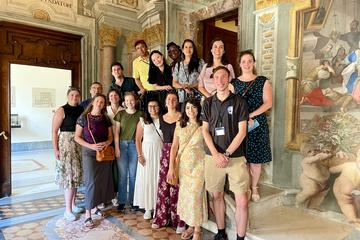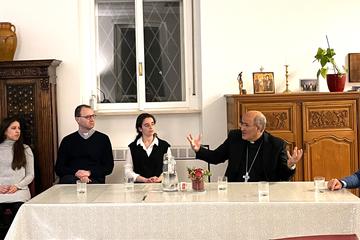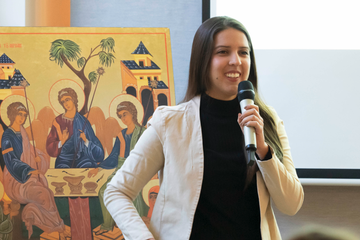In an opportunity to present the work of community members to an external audience, The Lay Centre held an “Open Day on Synodality” Nov. 12. The morning was rich in intellectual dialogue, held among Lay Centre residents and friends. Four scholars gave talks on topics directly or indirectly linked to the theme of synodality. The session was moderated by Loredana Fabijanic, an Angelicum doctoral student from Croatia.
Maria Teresa Ávila, an Angelicum licentiate student from Mexico, discussed the concept of “bridge-people,” that is, people who historically were bridge-builders between different social and ecclesiastical groups. She began by raising a question: “What are the characteristics of a bridge?” She picked up on one element in particular, the fact that bridges connect two separate entities.
- Aljaž Krajnc: ‘Religious diversity is willed by God,’ a reflection on human fraternity
- Bruno Hermes: The Gospel groups of Amazonia’s Acre River
- Clemency Flitter: Synodality and inclusion in the Church of England
- Adrian Teodor Oancea: Synodality and autocephaly in the Eastern Orthodox Church
- WATCH ALL ‘DIES ACADEMICUS’ LECTURES ON OUR YOUTUBE PAGE
“Bridge-people,” she said, are people who move on the frontiers, are able to speak two or more languages and translate for others, as well as inspire others to welcome and “make space” for newcomers. They also find common denominators: Where others only see divergence, opposition and dissent, bridge-people find common ground. Moreover, while they might differ in personality, area of study, ideology or politics, bridge-people have in common the ability to enlarge their own and others’ perspectives.
This definition led Ávila to quote from Pope Francis? recent encyclical letter “Fratelli Tutti”: “In imitation of Mary, the Mother of Jesus, we want to be a Church that serves, that leaves home and goes forth … in order to accompany life, to sustain hope, to be the sign of unity … to build bridges, to break down walls, to sow seeds of reconciliation” (276).
Bridge-people in history
Ávila provided concrete examples. The first group of bridge-people she considered were priests from the 1800s. She then turned to consider examples of lay women and men. They were:
- Severinus Boethius (480-525) was a Roman senator and philosopher, who bridged the classical philosophical and scientific tradition with Christianity. Ávila quoted Pope Benedict XVI: Boethius was convinced that harmony between cultures and values was possible, and considered his mission to reconcile and unite the Classic and the Roman culture.
- Robert Lammenais (1782-1854), a French priest and philosopher, who built bridges between the Catholic Church and democratic political movements, also supported the separation of church and state. Although he was officially condemned by the Church in his lifetime, his views are now upheld as part of Catholic social teaching.
- Antonio Rosmini (1797-1855), an Italian priest, who deplored the division between clergy and lay people in his book “The Five Wounds of the Church,” urged clergy and laity alike not to forget that they are one Body in Christ. Like Lammenais, he had problems with Church hierarchy during his life, but was beatified in 2006.
- Wilhelm von Ketteler (1811-1877), a German bishop famous for his dialogue with socialist theorist Ferdinand Lassalle, acted as a bridge between socialism and Catholicism, acknowledging the differences and similarities, and worked in favour of social ethics, worker rights, unions and the welfare state.
- Giuseppe Toniolo (1845-1918), a Catholic sociologist, economist and writer. He built bridges between Christianity and democracy and worked to integrate economic systems and moral principles, for example, by promoting labour unions. For this work, he was beatified by Pope Benedict XVI.
- Georges Rutten (1875-1952), a Dominican priest who lived with and wrote about the conditions of miners. He built bridges not only between the socialist class struggle and Christian social justice efforts, but also between academia and social action.
- Dorothy Day (1897-1980), an American journalist, activist and pacifist, was an anarchist in her youth and wrote for communist publications. After converting to Catholicism, she continued her radical activism, founding the Catholic Worker Movement with Peter Maurin.
- Eileen Egan (1912-2000), a lay Catholic writer, activist and journalist, was the first lay professional to work with Catholic Relief Services. She built bridges between Mother Teresa and organizations such as the National Council of Catholic Women, as well as between Christianity and pacifism through her work on the Consistent Life Ethic.
Ávila concluded her presentation with another quote from “Fratelli Tutti”: “Let us arm our children with the weapons of dialogue! Let us teach them to fight the good fight of the culture of encounter!” (217).
Contributed:
Filip Veber
Joseph Tulloch


